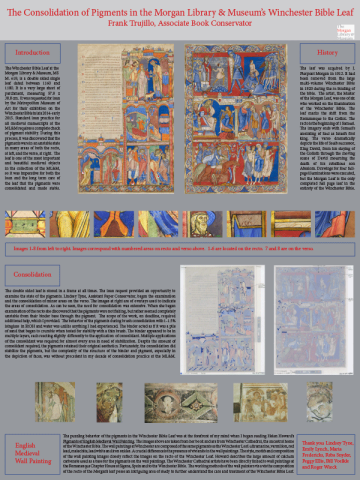This post was created by Frank Trujillo, Associate Book Conservator and Emily Lynch, Sherman Fairchild Post Graduate Fellow in Book Conservation.
Conservators working in the Thaw Conservation Center at the Morgan Library & Museum undertake technical research projects relating to the objects they are treating for the Morgan's robust exhibition and loan program, for digitization, and for scholarly access in the Reading Room.
Frank Trujillo, Associate Book Conservator and Emily Lynch, Sherman Fairchild Post-Graduate Fellow in Conservation, presented current research projects at the 2016 Care and Conservation of Manuscripts conference in Copenhagen. The conference draws an international audience of scholars in the fields of conservation and manuscript studies and provides an opportunity to exchange ideas and new research with colleagues. The primary means of exchange are lectures and poster sessions. The presentations below are PDFs of the posters created for the conference.
Frank Trujillo explores the pigments in the Morgan's Winchester Bible leaf (MS M. 619) as they relate to medieval wall painting techniques. Emily Lynch presents research on an alternative structure and materials for rebinding medieval manuscripts to specifically address the re-binding of the Hours of Catherine of Cleves (MS M.917/945). Further information on the manuscripts from the Medieval and Renaissance Manuscript department can be discovered throughout the Morgan’s website.
These conference presentations were created for the 16th Seminar on the Care and Conservation of Manuscripts, held at the University of Copenhagen, Faculty of Humanities, 2016.


